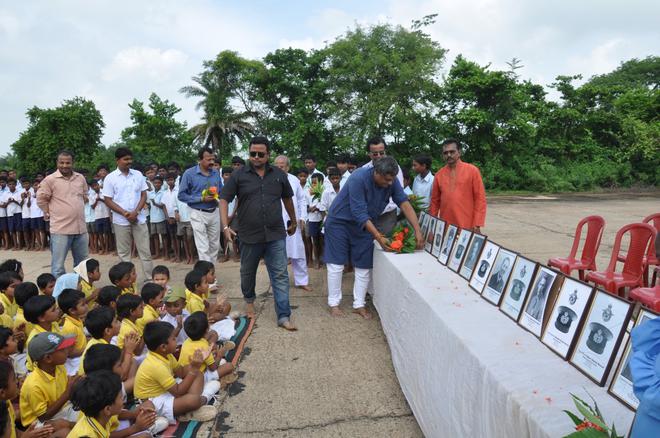A low altitude mid-air collision of two World War-II aircrafts that left 14 airmen dead over the skies of Odisha seven decades ago would have been relegated to deep crevices of history, but for efforts of a group of people quietly paying tribute and keeping the memory alive.
Two British Royal Air Force B-24 Liberator four-engine bombers, which were based at the Amarda Road airfield and were part of a six-plane contingent from the Air Fighting Training Unit, collided at low altitude during a training exercise on July 26, 1945.
The 14 airmen who died in the crash were of different nationalities such as British, American, Dutch, New Zealander, Australian; only one among them was Indian.
On July 26, local school children, Air Commodore Ran Singh, the Air Officer Commanding of Kalaikunda Air Station, activists and Morada MLA Rajkishore Das gathered at abandoned Amarda Road Air Strip, laid wreaths for each of the dead airmen, and held a memorial service by singing proper Christian prayers. Historian Anil Dhir, who has single-handedly dug out little details of the incident and the lives it claimed, has been leading the memorial service for 11 years now.

“Very few people know that the skies of Odisha had witnessed the crash of two aircrafts that resulted in the deaths of 14 airmen. The airstrip had a short but secret illustrious history, which has never been made public. This is a small effort to keep the memory alive,” said Mr. Dhir.
According to the historian, the airstrip had the longest runway in Asia, measuring over 3.5 km. The total length of runways, including taxiways and aprons, stood at 60 km.
“Today all is forgotten; no details of the activities that happened here between 1943 and 1945 exist, not even in government and military records. The station came into existence during the war as a forward airfield against the Japanese conquest of Burma.”
POGINANT STORY
After Internet revolutionised the our modes of communication, the historian managed to contact the living relatives of 10 of the dead. One of them was the 100-year-old brother of Flight Sergeant Cyril William Geeson, who had died at age of 23, and the other was the daughter of Flight Officer Peter Ettlinger.
“Ettlinger’s daughter, Yvonne, was just ten months old when her father was killed in the crash. He had never seen her. She has been researching the crash of her father from the last 50 years. In fact she has made three visits to India but could only visit her father’s grave at the Madras War Cemetery. She did not know about the Armada Strip and the crash site,” Mr. Dhir said.
“The relatives of these airmen were very surprised when I contacted them. Most of them had given up hope of knowing any more about the death of their loved ones. I got heartbreaking letters from them. The 100-year-old brother of Cyril Geeson tells me that he still remembers his brother every single day,” the historian shared.
“For Yvonne, it was a very emotive surprise when she received my email. She is a retired schoolteacher, now aged 67 years. I was deeply moved by the letters I received from them. It took me three years to trace the relatives of the only Indian, P.V. Mathai. The Malayala Manorama carried my story for weeks, until they got a response from the relatives,” he recalled.
The Airstrip
The large strip served its purpose well as a landing ground for planes and also as a training space for special bombing missions. The Amarda Road airstrip, as it was called in war terminology, spreads across an area of nearly 900 acres.
“Built in the 1940’s at a cost of ₹3 crore, it was eventually abandoned after the war. It was named as the Amarda Road Airfield due to the nearby Amarda Road railway station. Even today, seven decades after the base was made, one can still see the remains of the airfield with 11,000-feet concrete runway still intact,” Mr. Dhir pointed out.
“The offices, hangars, mechanic sheds and plaster walled barracks with thatched roofs have been ripped down. Instead, local women dry laundry and farmers their grain on the warm tarmac. The cows and goats crop weeds along the runway edges,” he said.
The group requested the government of Odisha and West Bengal to erect small memorials for these airmen at Amarda Road and the crash site. Mr. Dhir requested the government to open up the sealed underground bunker, which may hold relics of the period. Many advocated for setting up of a small museum that will highlight the importance of the airbase during World War II.
“The setting up of a Peace Museum was mooted last year and British, Australian, Dutch and USA authorities were contacted for material to be displayed at the museum. The response has been very positive,” said Mr. Dhir.
Mr. Das said that the abandoned airbase would soon be made operational under UDAAN scheme.







